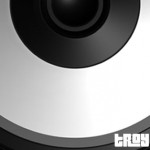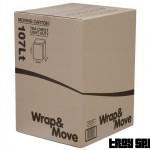We had a 3 Day Tour booked to leave from Ho Chi Minh City (Saigon) that includes a visit to the Cu Chi Tunnels.
I’ll write about the what we crammed into three day trip after I finish writing about the individual parts of the tour.
So if you ever get to Ho Chi Minh City in Vietnam you might want to book the same experience too.
To start with our bus tour pick up was at Thao Dien which is in District 2 in Ho Chi Minh City, so we were living just out of the city.
The drive to the Cu Chi Tunnels takes about an hour and a half depending on the traffic and we were told it is better to leave early to beat the crowds to the tunnels too.
As per normal, as we have found out from living in Vietnam, the traffic was bad getting out of the city and a little worse for a large bus.
If you have ever travelled to Vietnam you will know about the traffic and how congested it can be at peak times.
Motorbikes everywhere, so a little different than living in Biloela.
Once we were out of the city a bit it was ok and we were back on track.
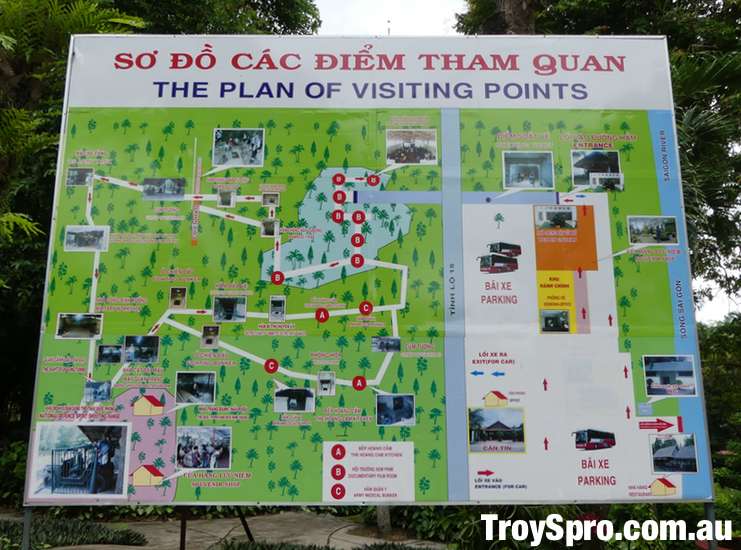
Tour Map of Cu Chi Tunnels in Vietnam
For people that don’t know, the Cu Chi Tunnels are an elaborate and huge network of connecting tunnels that were used during the Vietnam / American War.
The tunnels were used by the Viet Cong soldiers as the base for their operations in the Tet Offensive in 1968.
Many tunnels were dug out around Vietnam well before this but these particular tunnels were used during this time period and so there has been 121km of tunnels preserved by the Vietnamese Government and the public can visit them in two different sites.
When you visit the Cu Chi Tunnels you get an insider’s look into what life would have been like in the tunnels and also in the area generally.
Most of the tours start at the main entry where you buy your tickets then you head off into the site.
Our tour guide was very knowledgeable and spoke great English too, so this was a bonus.
We started walking around and headed into one of the huts for a talk from a local about the tunnels and what life would be like underneath the ground for them.
The tunnel systems were very elaborate. There were specific rooms set up for different purposes and they were all setup with different types of entrances and exits that were hidden to the untrained eye.
For instance fake termite nests or ant hills were used as breathing holes and more. Also different levels of rooms to get rid of smoke from fires were used too.
They had to be pretty elaborate and purposeful as the soldiers and locals had to stay underground for many days at a time when they were being bombed.
Because of these lengthy stays underground there were many health problems and deaths due to disease as well.
Most of the entries and exits to the tunnels were booby trapped and as you will see in the tour, these booby traps were pretty ruthless.
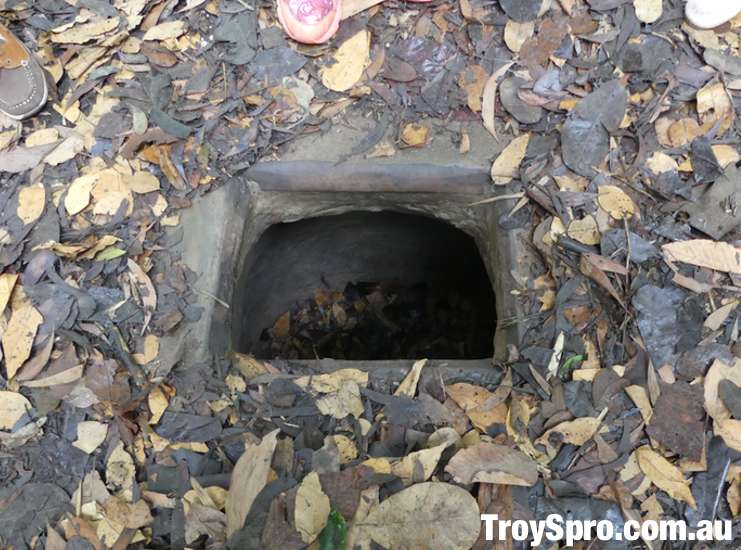
Tunnel Entry at the Cu Chi Tunnels
Next was a look at one of the trap doors where you get to hide under the ground to see how dark and also how small the tunnels would have been.
These trap doors were hidden by leaves and used as entry and exits to the tunnel system.
In this area also looked at a few of the other entries and exits to the tunnels that were used and explained the reasons they were used too.
As you walk around the area between the different displays you can’t help but wonder what life in the jungle would’ve been like for both sides.
The air is thick and humid and the vegetation is dense and we were told there are still areas in Vietnam and other surrounding countries with unexploded land mines and other ammunition too that still claim lives now.
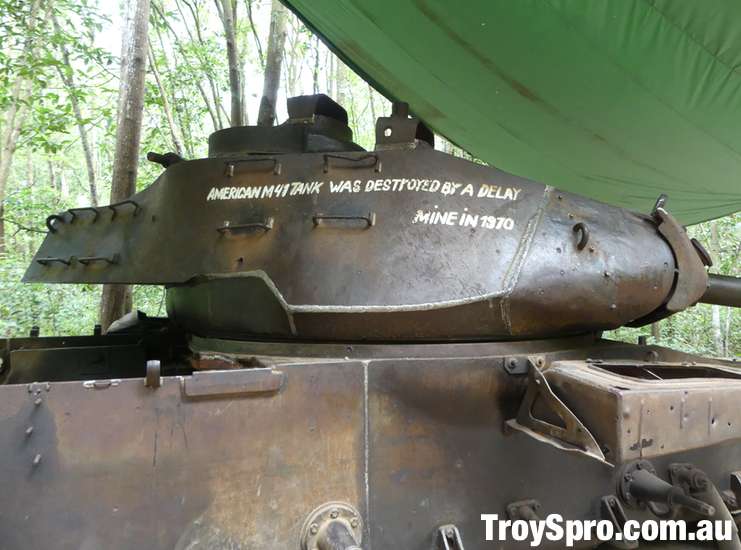
M4 American Tank
As you continue on the walk around the displays there is an American M4 Tank that was destroyed by a delay mine in 1970 as well as displays of the soldiers sitting above ground too.
Next it was onto the booby trap display where you see the traps that weren’t designed to kill straight away. They were designed to inflict wounds and the desired result after this was for the wounds to get infected and produce a slow death.
The bamboo and other spears used at the bottom of the traps were often covered with feces or similar so the infection would start almost immediately.
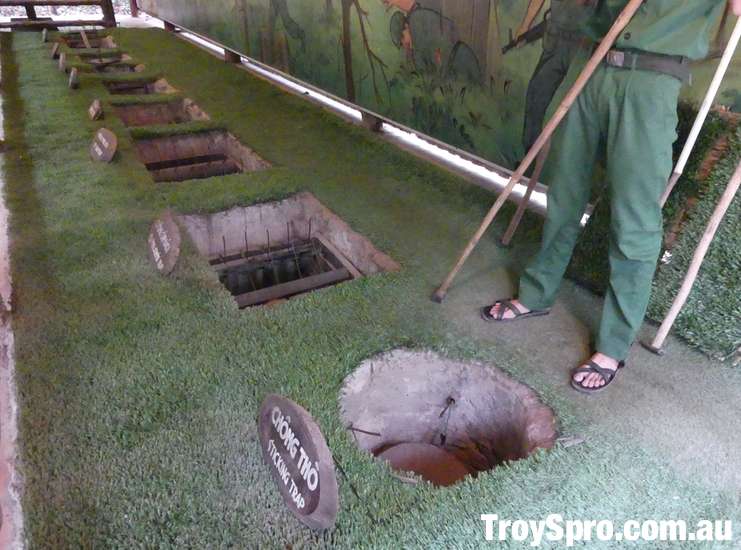
Booby Trap Display at Cu Chi Tunnels
These traps were laid around entrances and exits to the tunnels as well in the general areas.
They were made from whatever the soldiers could get their hands on (the Viet Cong were very resourceful), so there were deck chairs used as well as doors and much more.
The simplicity coupled with the effectiveness of these booby traps are a sight to see, until you sit there for a while and see these traps being demonstrated to you, you can’t really fully realise how painful they would’ve been.
Add into this the surprise aspect of actually standing or falling on one of them just adds to the whole experience too.
For us, after the booby trap display we headed off to another display where you see the weapons that were manufactured by the Viet Cong.
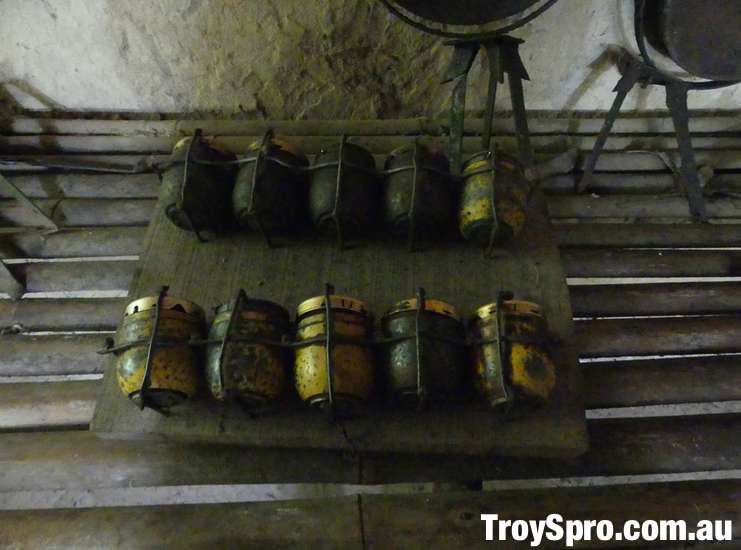
Landmines made out of Old Shells
They used whatever they could get their hands on and this meant making weapons out of what was either used on them or left behind by the soldiers fighting them.
They made grenades and land mines out of old shells and more that they found or acquired.
After this we moved onto the shooting range where you get to look at and fire if you want to assault rifles that were used during the war.
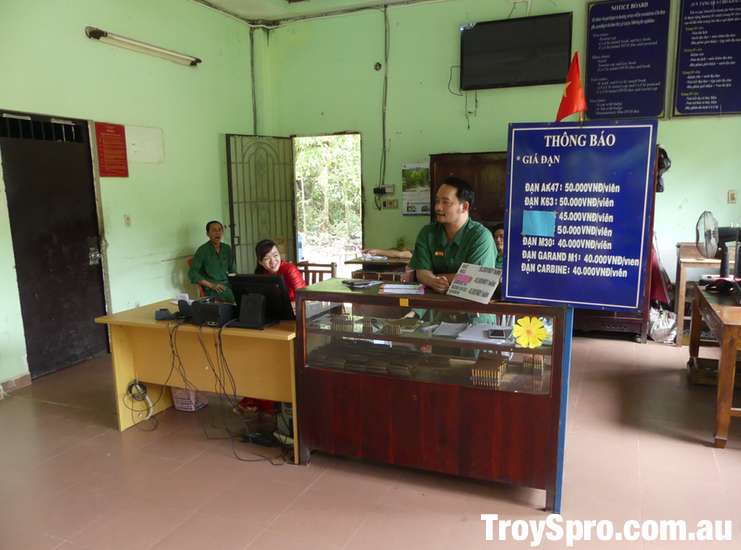
Cu Chi Tunnels Shooting Range Prices
As you can see in the photo the prices are on the board for you and just out of shot is all of the rifles lined up ready for action.
In this area there is also shops and also huts where you can see a lady make rice paper for eating and also a man making jandles / thongs / shoes out of tyre rubber.
We were told these shoes were designed to confuse so that the Americans and their allies didn’t know which way they were heading.
So the front and back are the same size and also the tread was designed to run backwards and forwards.
After this we headed off for the tunnel experience where you get to go underground in a section of tunnel they have kept for tourists.
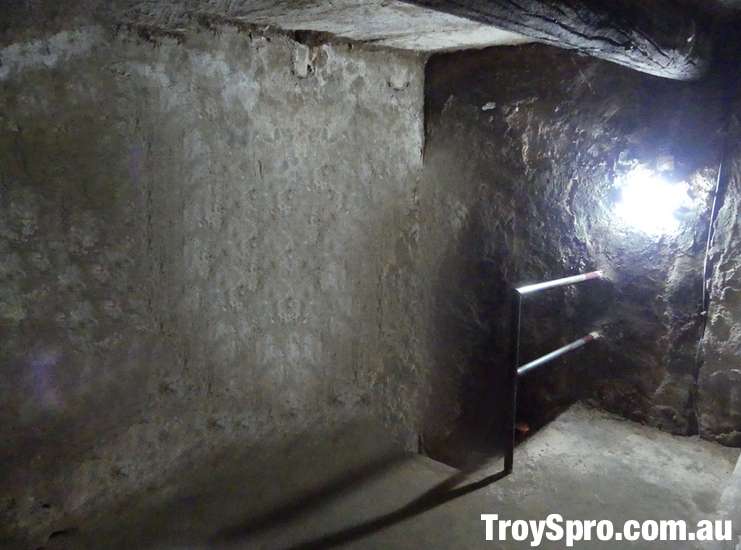
Underground Tunnel at Cu Chi Tunnels
They have widened it in sections and you get to crawl along for a short period or long, so however long you can handle it for.
The air is dense and thick underground too, so it gives you a small insight into life in the tunnels.
If you are claustrophobic, this is definitely not a part of the visit to the Cu Chi Tunnels you will be involved in.
After the tunnel crawl we went to a tent to have a drink and something to eat. It is meant to give you a glimpse into some of the foods that were eaten by the soldiers when underground. It consisted of boiled tapioca dipped in salt mix and a corn syrup drink that wasn’t too bad.
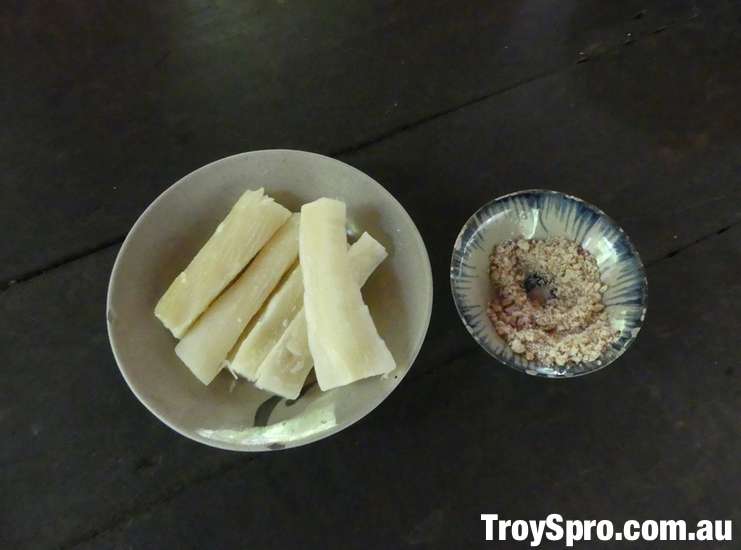
Cu Chi Tunnels Tour Meal
I’m sure they would have eaten whatever protein source they could get their hands on at the time to survive and mixed it with rice or eaten the rations left by the soldiers they were fighting against too.
After the meal we walked through a few more displays and sat and watched a video in a hut about the area, the locals and the tunnels which was very interesting indeed.
It was in black and white and very old, so the perspective was very different to anything I have seen before.
Lastly it was a walk through a few more displays and time to get in the bus and head back to the city getting ready for our trip away to Ben Tre and Can Tho.
So a visit to the Cu Chi Tunnels is a very though provoking experience that I would recommend to anyone who is in Ho Chi Minh City (Saigon).
Prices vary from tour to tour company and there are plenty to choose from as well.
You could either book a tour before you arrive or book after you arrive, most hotels are only too happy to help you out or if you are staying in the middle of Ho Chi Minh City you can almost find a tour company cluster every five shops or so offering many different options.
If you want to organise travel out to Cu Chi Tunnels yourself here are the details for you.
Cu Chi Tunnels Contact and Location
Here are the contact details and address of the Cu Chi Tunnels and also a link to Google Maps for you.
Most of the time you would be travelling out with a tour to the tunnels, but at least by having a look at the location on the map you’ll can see where it is located in regards to where you’re staying.
Cu Chi Tunnels Address
Provincial road 15, Phu Hiep, Phu My Hung,
Cu Chi, Ho Chi Minh City 733814, Vietnam
Google Maps Link for the Cu Chi Tunnels location
Phone 028 3794 8830
Cu Chi Tunnels Opening Hours
9am to 5pm Daily Monday to Sunday.
So yes, the Cu Chi Tunnels are open all day on a Sunday too.
Cu Chi Tunnels Ticket Prices
If you get a tour company to take you out to visit the Cu Chi Tunnels the prices are all different depending on the length of time you are out there.
Also how they get you out there (bus or people mover) and if they pick you up from your hotel etc.
So just look at the different prices online for Cu Chi Tunnels tour prices and you should get a good feel to what you will pay an then make your choice.
If you want to venture out there yourself you can catch buses out there (or taxi or Grab) and pay the 110,000 VND ticket price.
